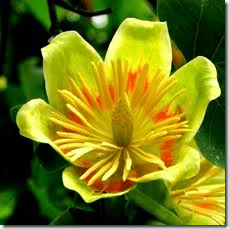Liriodendron tulipifera is called the tulip poplar, tulip tree or yellow poplar, taking its name from the tulip-shaped yellow flowers it displays in the spring. It is actually not a poplar at all, since it is a member of the Magnoliaceae, or magnolia, family. This tree grows rapidly in its early years and attains a full height of 80 to 120 feet in about 50 years.
Full Age
-
These trees die naturally at about 200 to 250 years. A tulip poplar that grows in particularly favorable conditions may live for up to 300 years. They do best in rich, well-drained soil with a fairly loose texture and a pH of 4.5 to 7.5. They do not tolerate drought or extremely wet conditions.
Age Limitations
-
The majority of tulip poplars do not reach the greatest possible age because these trees are very vulnerable to wind damage. Ice damage is also a problem. The wood is rather brittle and breaks quite easily, and the dense foliage catches the wind in much the way that a sail does. However, the tulip popular regenerates easily from stump growth, as well as seed reproduction. This, coupled with their fast growth rate, makes them a stable presence in a mixed forest, as fallen trees are quickly replaced.
Tulip Poplar at Monticello
-
A venerable tulip poplar was cut down in 2008 at Monticello because it was posing a threat to its surroundings. This may have been the tree Thomas Jefferson described in his garden notes on April 16, 1807: "planted 1. Laurodendron in margin of S. W. shrub circle from the nursery." Certainly he admired the tulip poplar, calling it "The Juno of our Groves" when he sent seeds to friends in Paris. Arborists can usually date a tree by counting the tree rings, but this tree had a hollow trunk for a long time, perhaps as long as 100 years.
Uses of the Tulip Poplar
-
The tulip poplar is a popular shade tree and specimen tree, if enough space is available. Its wood is important commercially and used in making furniture and musical instruments. It is increasingly used as a substitute for scarce softwoods. Bees that feed on the flowers of a tulip poplar produce a distinctive honey.


Deprecated: strpos(): Passing null to parameter #1 ($haystack) of type string is deprecated in /home/agriviek8Qv/agriviet.net/public_html/wp-includes/comment-template.php on line 2522